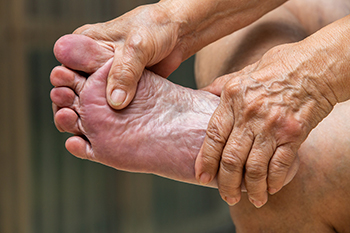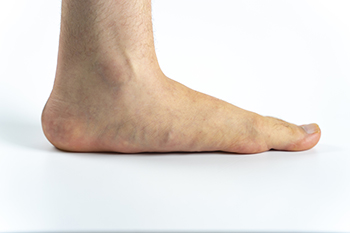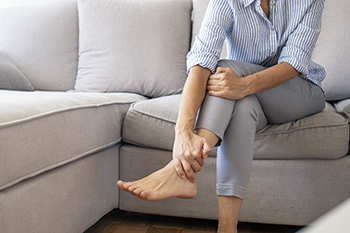Connect With Us
Items filtered by date: June 2023
Reasons Blisters Develop on the Feet

A common reason for blisters to develop on the feet is excessive pressure. This can happen as a result of wearing shoes that do not fit correctly, which may cause a part of the foot to rub against the shoe. A blister looks like a small bubble. It is filled with liquid and protects the damaged skin until it is replaced by new skin. It will gradually drain when the healing process is completed, and it is beneficial to refrain from prematurely popping it. Additional reasons to get a blister on the foot can consist of enduring a bad sunburn or having an allergic reaction to an insect bite. They may also develop from having an illness such as chickenpox. Treatment can begin with changing the shoes that are worn, followed by keeping the affected area clean and dry. Some people find it helpful to wear a protective covering over the blister until it has healed. If you have a blister on your foot, it is suggested that you consult with a podiatrist who can help you properly manage this condition.
Blisters are prone to making everyday activities extremely uncomfortable. If your feet are hurting, contact Ali Davis, DPM of The Foot Clinic. Our doctor can provide the care you need to keep you pain-free and on your feet.
Foot Blisters
Foot blisters develop as a result of constantly wearing tight or ill-fitting footwear. This happens due to the constant rubbing from the shoe, which can often lead to pain.
What Are Foot Blisters?
A foot blister is a small fluid-filled pocket that forms on the upper-most layer of the skin. Blisters are filled with clear fluid and can lead to blood drainage or pus if the area becomes infected.
How Do Blisters Form?
Blisters on the feet are often the result of constant friction of skin and material, usually by shoe rubbing. Walking in sandals, boots, or shoes that don’t fit properly for long periods of time can result in a blister. Having consistent foot moisture and humidity can easily lead to blister formation.
Prevention & Treatment
It is important to properly care for the affected area in order to prevent infection and ease the pain. Do not lance the blister and use a Band-Aid to provide pain relief. Also, be sure to keep your feet dry and wear proper fitting shoes. If you see blood or pus in a blister, seek assistance from a podiatrist.
If you have any questions, please feel free to contact our office located in Overland Park, KS . We offer the newest diagnostic and treatment technologies for all your foot care needs.
How Aging Can Affect Your Feet

Anyone in their senior years is no stranger to pain, but changes in the feet are often ignored. One of the ways the feet can change with aging is a loss of natural cushioning, particularly in the heel pads. At the same time, as the skin in the feet gets thinner and loses elasticity, the risk of foot injuries increases. A common injury is plantar fasciitis, which is the direct result of loss of elasticity that can cause the arch to collapse. This places more pressure on the feet to absorb shock and weight, producing foot pain. Such an occurrence, in turn, can negatively affect the legs, knees, hips, and back. Conditions such as arthritis, diabetes, and obesity are other causes of foot pain as a person ages. Becoming more sedentary only adds to the risk of pain in the feet. Experts believe that light stretching and strength exercises are a good way to stave off foot pain. Wearing more supportive shoes that have ample cushioning can make a difference. And in some cases, investing in a pair of custom orthotics, or shoe inserts, is a solution. For more information about dealing with foot pain as you age, it is suggested that you seek the counsel of a podiatrist.
Proper foot care is something many older adults forget to consider. If you have any concerns about your feet and ankles, contact Ali Davis, DPM from The Foot Clinic. Our doctor can provide the care you need to keep you pain-free and on your feet.
The Elderly and Their Feet
As we age we start to notice many changes in our body, but the elder population may not notice them right away. Medical conditions may prevent the elderly to take notice of their foot health right away. Poor vision is a lead contributor to not taking action for the elderly.
Common Conditions
- Neuropathy – can reduce feeling in the feet and can hide many life-threatening medical conditions.
- Reduced flexibility – prevents the ability of proper toenail trimming, and foot cleaning. If left untreated, it may lead to further medical issues.
- Foot sores – amongst the older population can be serious before they are discovered. Some of the problematic conditions they may face are:
- Gouging toenails affecting nearby toe
- Shoes that don’t fit properly
- Pressure sores
- Loss of circulation in legs & feet
- Edema & swelling of feet and ankles
Susceptible Infections
Diabetes and poor circulation can cause general loss of sensitivity over the years, turning a simple cut into a serious issue.
If you have any questions please feel free to contact our office located in Overland Park, KS . We offer the newest diagnostic and treatment technologies for all your foot and ankle needs.
Why the Bottom of Your Feet May Hurt

If you have pain in the bottom of your feet, you may be wondering why that is. You might be feeling sharp pains or throbbing soreness. Given how complex the feet are and the many bones, joints, muscles, and ligaments they have, there are many reasons this can happen. One possibility is that you are experiencing symptoms of flat feet. This is the foot condition when the entire sole touches the ground. The types of flat feet are flexible and rigid flat feet. Flexible flat foot is the most common and occurs when the foot is only flat when weight is put on it. Rigid flat foot is flat whether weight is put on the foot or not. This latter type of flat feet may be from the tarsal coalition, which is an ailment where bones have grown together. Additionally, congenital conditions or arthritis may lead to having flat feet. The correct treatment depends on the type of flat foot you have. Relief may be found by stretching the foot, strengthening the arch, or wearing orthotics. Surgery may also be a possibility for permanent relief. If you have flat feet and they are causing you pain, it is suggested that you see a podiatrist for an evaluation and a proper treatment plan.
Flatfoot is a condition many people suffer from. If you have flat feet, contact Ali Davis, DPM from The Foot Clinic. Our doctor will treat your foot and ankle needs.
What Are Flat Feet?
Flatfoot is a condition in which the arch of the foot is depressed and the sole of the foot is almost completely in contact with the ground. About 20-30% of the population generally has flat feet because their arches never formed during growth.
Conditions & Problems:
Having flat feet makes it difficult to run or walk because of the stress placed on the ankles.
Alignment – The general alignment of your legs can be disrupted, because the ankles move inward which can cause major discomfort.
Knees – If you have complications with your knees, flat feet can be a contributor to arthritis in that area.
Symptoms
- Pain around the heel or arch area
- Trouble standing on the tip toe
- Swelling around the inside of the ankle
- Flat look to one or both feet
- Having your shoes feel uneven when worn
Treatment
If you are experiencing pain and stress on the foot you may weaken the posterior tibial tendon, which runs around the inside of the ankle.
If you have any questions please feel free to contact our office located in Overland Park, KS . We offer the newest diagnostic and treatment technologies for all your foot and ankle needs.
Help for Arthritic Foot Pain

Arthritis in the feet can cause significant discomfort and interfere with normal functioning. Arthritis is a condition that leads to inflammation in or around joints. Symptoms include pain, swelling, and stiffness. The two major categories of arthritis are osteoarthritis and inflammatory arthritis. Osteoarthritis is the most common form of arthritis. This causes the cartilage between the bones at the joints to gradually erode with use. When this happens, the bones will grind against each other. This type of arthritis often affects the joint of the big toe. Bone spurs can develop on the joint to try to protect it, but often results in more pain and decreased motion of the joint. Gout is another form of arthritis that can cause severe joint pain in the big toe. Men, and women who are postmenopausal, are most susceptible to this affliction. Gout develops from high uric acid levels in the blood, and this causes deposits of urate crystals to form around joints. Though there is no cure for arthritis, there are relief strategies that can be employed. If you suffer from arthritis in your feet, it is suggested that you visit a podiatrist who can provide more information about these approaches to relief.
Arthritis can be a difficult condition to live with. If you are seeking treatment, contact Ali Davis, DPM from The Foot Clinic. Our doctor can provide the care you need to keep you pain-free and on your feet.
Arthritic Foot Care
Arthritis is a joint disorder that involves the inflammation of different joints in your body, such as those in your feet. Arthritis is often caused by a degenerative joint disease and causes mild to severe pain in all affected areas. In addition to this, swelling and stiffness in the affected joints can also be a common symptom of arthritis.
In many cases, wearing ill-fitting shoes can worsen the effects and pain of arthritis. Wearing shoes that have a lower heel and extra room can help your feet feel more comfortable. In cases of rheumatoid arthritis, the arch in your foot may become problematic. Buying shoes with proper arch support that contour to your feet can help immensely.
Alleviating Arthritic Pain
- Exercises that stretch the foot can prevent further pain and injury and increase mobility
- Most of the pain can be alleviated with anti-inflammatory drugs, heat, and topical medications
- Massages can help temporarily alleviate pain.
It is best to see your doctor for the treatment that is right for your needs and symptoms. Conditions vary, and a podiatrist can help you determine the right method of care for your feet.
If you have any questions, please feel free to contact our office located in Overland Park, KS . We offer the newest diagnostic tools and technology to treat your foot and ankle needs.
Wounds That Don't Heal Need to Be Checked
Blog Archives
- April 2024
- March 2024
- February 2024
- January 2024
- December 2023
- November 2023
- October 2023
- September 2023
- August 2023
- July 2023
- June 2023
- May 2023
- April 2023
- March 2023
- February 2023
- January 2023
- December 2022
- November 2022
- October 2022
- September 2022
- August 2022
- July 2022
- June 2022
- May 2022
- April 2022
- March 2022
- February 2022
- January 2022
- December 2021
- November 2021
- October 2021
- September 2021
- August 2021
- July 2021
- June 2021
- May 2021
- April 2021
- March 2021
- February 2021
- January 2021
- December 2020
- November 2020
- October 2020
- September 2020
- August 2020
- July 2020
- June 2020
- May 2020
- April 2020
- March 2020
- February 2020
- January 2020
- December 2019
- November 2019
- October 2019
- September 2019

